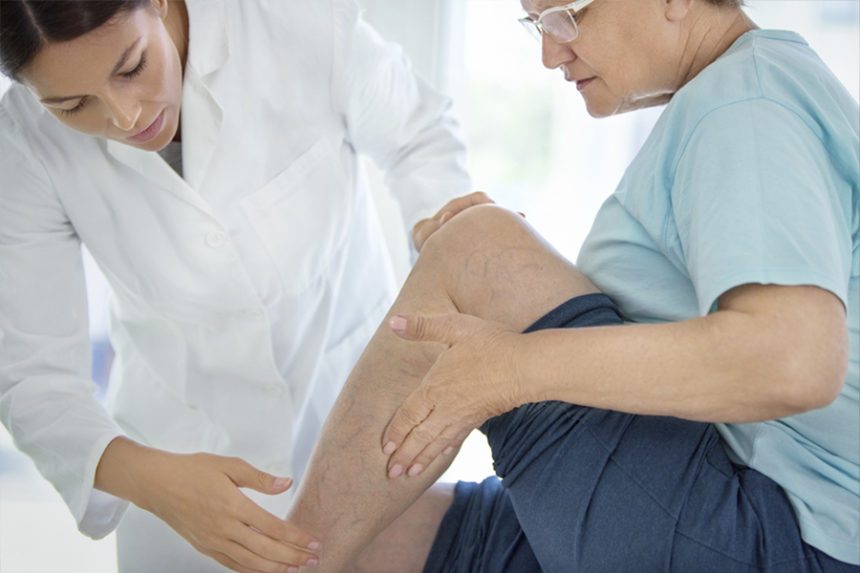If you experience leg pain as you get older, you may chalk it up to a normal part of aging or early signs of arthritis. However, it could be a more serious but relatively common condition called peripheral arterial disease, often known as PAD. Approximately 6.5 million people age 40 and older in the United States have PAD. It can cause serious health problems if it isn’t treated.
To learn more, we asked UNC Hospitals vascular specialists Mark Farber, MD, William Marston, MD, and Luigi Pascarella, MD, to explain PAD and what to do if you’re diagnosed.
What is peripheral arterial disease (PAD)?
Arteries carry blood from your heart to other parts of your body. Your tissues need this blood for oxygen and nutrients.
Peripheral arterial disease occurs when arteries in your extremities (limbs) narrow, which reduces blood flow to your legs, thighs, buttocks or arms. This is caused by a buildup of a fatty substance called plaque, a condition called atherosclerosis.
Atherosclerosis can occur in other parts of your body and cause heart disease and stroke. Patients with PAD are also at increased risk for both of these conditions.
“When arteries develop blockages that get to be severe enough, they begin to limit blood flow. If it’s blood flow to your heart, you can suffer a heart attack. When it’s blood flow to your brain, you may have particles that break loose and cause ministrokes. When there is blood flow limitation to your legs, you develop leg pain,” Dr. Farber says.
When your legs or arms (more commonly your legs) don’t receive enough blood flow to keep up with demand, it can cause pain and cramping. A typical experience is pain in the calves, with walking that gets better after rest. Occasionally you may also feel cramping in the arms, hips, thighs or buttocks.
It is important to note that some people with PAD do not experience any symptoms, and in these cases medical management is appropriate.
However, “in some cases, if left untreated, patients will need to have amputation of the toes and legs if blood flow is limited severely,” Dr. Farber says. “So early recognition and treatment are essential.”
What are the risk factors for PAD?
Risk factors for peripheral arterial disease include:
- Smoking
- High cholesterol
- High blood pressure
- Diabetes
- Age over 60
“Smoking and high cholesterol are the two biggest factors for PAD. There are some genetic factors, but they are not nearly as prevalent as smoking and cholesterol,” Dr. Farber says.
Diabetes also increases the risk of PAD, especially Type II diabetes.
“Now that we see so many juveniles getting diabetes, we’re seeing younger and younger people who get PAD that’s associated with diabetes,” Dr. Marston says.
How is peripheral arterial disease diagnosed?
If you or your primary care physician suspect you have PAD, you should see a vascular doctor. A vascular doctor specializes in diagnosing and treating issues that affect your veins and arteries, such as PAD. Though your vascular doctor is trained to perform many kinds of procedures including surgery, they also can help you manage your PAD through lifestyle modifications such as smoking cessation and putting you on medicines that can help lower your cholesterol or blood pressure.
“Sometimes people think that a vascular surgeon is going to do a big major operation on them, and that’s not what vascular surgeons do. We are, in a sense, primary care specialists because we manage all the aspects of the patient’s vascular disease,” Dr. Farber says. “We follow these patients for years sometimes before we may need to do an intervention.”
Before your doctor can treat you, they will need to confirm a PAD diagnosis with a physical exam. Your doctor will typically check your cholesterol and may order imaging tests to see the blood flow to your arms and legs. This will help determine what type of treatment is best for you.
How is peripheral arterial disease treated?
Your doctor can prescribe medications that can reduce your chance of developing complications from PAD. These could include statins and other drugs that can reduce blood cholesterol levels or drugs that can lower blood pressure.
Treatment plans usually include lifestyle changes that can ease symptoms and the progression of peripheral arterial disease. Since smoking is one of the most significant risk factors for PAD, it’s important to start a smoking cessation program if you smoke. Improving your diet and increasing your physical activity can help lower your cholesterol.
If you have diabetes, you may be referred to a clinic such as the UNC Diabetes Care Center for help managing your diabetes.
“If your PAD is too severe or the lifestyle and medication options are not working, then we can intervene with minimally invasive or more invasive procedures depending on where the blockage is and how many you have,” Dr. Farber says.
Treatments for PAD include:
- Balloon angioplasty with or without stenting: A vascular specialist threads a catheter to the affected artery and inflates a small balloon to reopen it. Sometimes a stent needs to be inserted to keep the artery open.
- Lower extremity bypass surgery: A vascular specialist uses one of your veins or a synthetic graft to “bypass” and reroute blood around a blocked artery in one of your legs.
“Depending on the location, leg blood flow can be improved with minimally invasive options such as balloons or stents, and sometimes the problem is more extensive. Then, a bypass or surgical procedure is needed to reroute blood flow around the blockages,” Dr. Pascarella says. “We do what’s best for the patient based on all the options that we have.”
Worried about leg pain? Talk to your doctor about getting a referral to UNC Heart and Vascular. Need a doctor? Find one near you.

